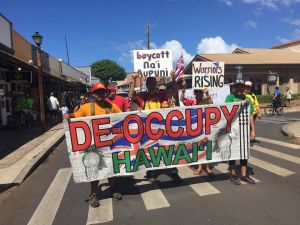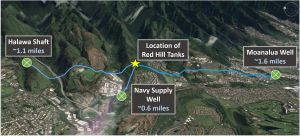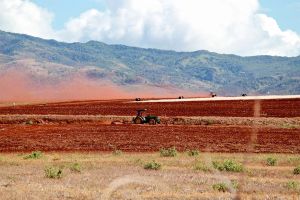Ka Pae Aina: Difference between revisions
Florez4747 (talk | contribs) |
Florez4747 (talk | contribs) |
||
| Line 76: | Line 76: | ||
== Hartung Brothers Inc. == | == Hartung Brothers Inc. == | ||
In 2017 [[Hartung Brothers Inc.]] completed an acquisition of Syngenta Seeds Hawaii Operations.<Ref>https://www.seedtoday.com/article/121164/hartung-brothers-inc-completes-acquisition-of-syngenta-operations-in-hawaii</Ref> Ed Attema, Syngenta head of Global Seed Operations, Production & Supply, stated, in regards to the acquisition of their land on Oahu and Kauai, “We are extremely pleased to have this agreement with Hartung Brothers for our Hawaii sites. The goal has been to have our employee talent base and facilities maintained and to contract work with the new owner, and that will be achieved.”<Ref>https://www.hortidaily.com/article/6034766/us-hartung-brothers-to-acquire-syngenta-operations-in-hawaii/</Ref> <br> | In 2017 [[Hartung Brothers Inc.]] completed an acquisition of Syngenta Seeds Hawaii Operations and acts as a contractor for all Syngenta related activites.<Ref>https://www.seedtoday.com/article/121164/hartung-brothers-inc-completes-acquisition-of-syngenta-operations-in-hawaii</Ref> Ed Attema, Syngenta head of Global Seed Operations, Production & Supply, stated, in regards to the acquisition of their land on Oahu and Kauai, “We are extremely pleased to have this agreement with Hartung Brothers for our Hawaii sites. The goal has been to have our employee talent base and facilities maintained and to contract work with the new owner, and that will be achieved.”<Ref>https://www.hortidaily.com/article/6034766/us-hartung-brothers-to-acquire-syngenta-operations-in-hawaii/</Ref> <br> | ||
On the [[Hartung Brothers Inc.]] website it explains how they are continuing Syngentas legacy of dangerous experimental GMO testing/ research and development: "Our seed research and development operations in Hawaii, enables us to offer end-to-end turn-key services, including: contract R&D service to customer genetics and protocols, foundation seed production, pilot hybrids, and hybrid production, processing, warehousing, and distribution."<Ref>https://hartungbrothers.com/source-from-us/</Ref> | On the [[Hartung Brothers Inc.]] website it explains how they are continuing Syngentas legacy of dangerous experimental GMO testing/ research and development: "Our seed research and development operations in Hawaii, enables us to offer end-to-end turn-key services, including: contract R&D service to customer genetics and protocols, foundation seed production, pilot hybrids, and hybrid production, processing, warehousing, and distribution."<Ref>https://hartungbrothers.com/source-from-us/</Ref> | ||
Revision as of 20:16, 9 February 2023
"Ka Pae Aina (the Hawai’ian Archipelago) is made up of 137 islands, reefs and ledges stretching 2,451 kilometres southeast / northwest in the Pacific Ocean and covering a total of 16,640 square kilometres. The Kanaka Maoli, the Indigenous Peoples of Ka Pae Aina or Hawai’i, make up around 20% of the total population of 1.2 million. In 1893, the Government of Hawai’i, led by Queen Lili’uokalani, was illegally overthrown and a provisional government established without the consent of the Kanaka Maoli and in violation of international treaties and law. It was officially annexed by the United States and became the Territory of Hawaii in 1898. Hawaii acquired statehood in 1959 and became a part of the United States of America. The Kanaka Maoli continue to fight for self-determination and self-government and continue to suffer from past injustices and ongoing violations of their rights. Some members are involved in the Hawai’ian sovereignty movement, which considers the overthrow of the Kingdom of Hawai’i in 1893 illegal, along with the subsequent annexation of Hawai’i by the United States. Among other things, the movement seeks free association with and/or independence from the United States."[1]
Queen Lili’uokalani
1893 Colonization
Military Occupation
Kaho'olawe Test Bombings
After the attack on Pearl Harbor in 1941, the United States declared martial law on Ka Pae Aina. In May of 1941, the US Army leased a small section of Kaho’olawe from cattle ranchers for $1.00 a year[2]; Kaho'olawe, an island held sacred by The Kanaka Maoli, was then confiscated and turned into a US air-force test bombing site.[3] "In ancient times, the sacred island of Kaho’olawe was, according to local tradition, the Hawaiian peoples’ center for celestial navigation, a bountiful fishing grounds, and a spot where native priests carried out cultural and religious rites. In the modern era, the 45 square-mile area has been dubbed “the most shot island in the world.”"[4]
Even before war converted Kaho’olawe into the Pacific’s target range, visitors and residents had already ensured the island was well on its way to ruin. The abasement started when goats were introduced in 1793. Already sweltering in Maui’s rain shadow, much of Kaho’olawe’s heartiest vegetation disappeared due to the animals. In 1832, the island became the home of a penal colony. By 1858, official leases to ranching companies allowed sheep, cattle, and even more goats to roam and gobble, leading to severe erosion and soil loss. Rats and feral cats followed the people and livestock, quickly overpowering the natural fauna. Non-native trees, grasses, and shrubs brought in as feed further skewed the island’s natural balance.[5]
In 1965 Operation Sailor Hats was conducted on the island and consisted of three detonations with 500 tons of TNT being detonated to simulate the blast effects of nuclear weapons on shipboard weapon systems.[6]
"We had to save the island," said activist Walter Ritte.
In 1976, Ritte and other members of the Protect Kahoolawe Ohana began a series of occupations on the island, risking arrest or death as they tried to stop the bombing. Two men, George Helm and Kimo Mitchell, were lost at sea while returning from a trip to Kahoolawe.
"It was a huge story," said Nainoa Thompson, president of the Polynesian Voyaging Society. "They would take on the whole federal government, the military, the Navy. Yikes.
"And the federal government and the Navy couldn't do anything because they are willing to give up everything. They weren't compromising. And that whole statement was revolutionary for everyone that wanted to see that there was some justice to the native people in their own homeland."
Ritte said it was not only the cries for help from the Hawaiian people that drove them back to the island, but the cries from the land.
"It was some kind of an experience, but when I was looking at this rock and the (military) helicopter went straight up and I was just fixed on that rock and then the rock became the whole island. And I felt this tingling coming into my body and … I kind of lost it, I mean, I couldn't remember too much but I knew that island was going to die," he said...
...Some traveled to Washington D.C. to meet with the president, while thousands of others wrote to local politicians and met with the media. Meanwhile, Ritte and Richard Sawyer would stay on the island for the longest occupation — 35 days..
"We had to eat coconuts from the beach and pound eels with the rock to kill the eel and eat the eel," Ritte said. "We even had to start eating baby goats and stuff just to survive."
Military personnel were sent out to search for the two — each time finding no sign of them.
"Richard and I ducked for cover … and the ground was shaking and bombs were dropping. Our wives kept telling them they're on the island, they're on the island," Ritte said. "And the senators gave the OK — it's all clear start bombing. We could've been blown up."
"It changed my whole life. From that day."[7]
Protect Kahoolawe Ohana sued the United States military after the occupation and the bombing was eventually ordered to end; In 1993 congress voted to end all military usage of the island and transfer the island back to the state of Hawaii. Despite the military being officially ordered to cease all operations on Kaho'olawe the damage had already been done and the island was littered with bomb debris and unexploded ordnance. Since the transfer, more than 9 million pounds of unexploded ordnance and other remnants have been cleared from the island. [8]
Red Hill Bulk Fuel Storage Facility
On January, 13th 2014 27,000 gallons of jet fuel leaked from the storage tanks at the United States Military's Red Hills Fuel Storage Facility in Moanalua.[9] The storage tanks at this cite are the biggest of their kind in the so called United States and sit only 100 feet above one of Oʻahu's main aquifers. The fuel tank leaks continue to this day, in part because the storage containers are old and small holes were found and claimed as the cause of the leak,[10] additionally there has been petroleum found in water sources.[11] [12]
On May 6th, 2021 another leak occurred at the Red Hills Fuel Storage Facility releasing 19,000 gallons of JP-5 jet fuel into other storage containers causing pressure buildup in neighboring fuel lines. The spilled fuel remained in the other pipeline for six months before rupturing and spilling fuel into the tunnel system near the Red Hill drinking water system shaft.[13] Residents were still feeling side effects resulting from contaminated water a year later according to a survey conducted, but the actual number of effected residents was likely underestimated. 80% of respondents to the survey, 788 people, reported symptoms in the last 30 days such as headaches, skin irritation, fatigue and difficulty sleeping. Of those who were pregnant during the crisis, 72% experienced complications.[14] The Navy has pumped and dumped over a billion gallons of water from Oahu’s primary aquifer in an effort to clean up the fuel contamination and has assured residents that the drinking water is safe despite continued reports of people feeling side effects after ingesting water.[15]
"Though the Pentagon has committed to shutting down the Red Hill fuel tanks within two years... A report released in June 2022 states that the U.S. Navy was negligent in the maintenance of the fuel tanks, resulting in (preventable) leaks. The U.S. Navy has begun to defuel some pipelines but is proposing to have the fuel tanks closed by 2027 and to stay in place for potential use in the future."[16] [17]
Forever Chemicals
The EPA and state Health Department said in a letter to the Navy that PFAS ― known as forever chemicals ― were detected in groundwater samples on Dec. 20 and 27, 2021 relating to fuel leakages at the Red Hill military fuel storage site.[18] Hawaii News Now reported about the contamination of groundwater before the letter- [19] The reporting came after some 1,300 gallons of AFFF concentrate was spilled inside a tunnel at the Navy’s underground Red Hill fuel facility on Nov. 29 2022[20]
Aqueous film forming foam, also known as AFFF, was released on the upper end of the facility into the aboveground soil and into the underground facility, the health department said in a news release. AFFF is used to suppress fuel fires and contains chemicals known as PFAS that are linked to cancer and other health problems. PFAS chemicals are notorious environmental contaminants because they are “forever chemicals” that don’t break down in the environment.[21]
Experimental Biotechnology
Since the early 1990's over 3,300 permits have been issued for testing genetically engineered crops.[22]
Papayas
Genetically modified Papaya plants dominate the industry in Ka Pae Aina after being introduced in an attempt to combat the Papaya ringspot virus, which was decimating crops across Hawaii.[23]
Syngenta
According to Syngenta's website they "... invest and innovate to transform the way crops are grown and protected to bring about positive, lasting change in agriculture. We help farmers manage a complex set of challenges from nature and society. Our approach is to ensure that everybody wins: that farmers are prosperous, agriculture becomes more sustainable, and consumers have safe, healthy and nutritious food."[24]
Syngenta's method of achieving these, seemingly, noble goals is by wantonly spraying toxic pesticides and insecticides over crops to test their resistance to the chemicals and as a result the Ka Pae Aina's Native residents have been poisoned enmasse by these loosely regulated experiments. Residents have described the test sites as releasing large red dust clouds into the air covering their houses and cars with a thin layer of red- especially during periods of high winds. Because the island is able to grow food year round these types of experiments, involving mass chemical spraying of crops, also occur year round.[25] The mass testing of toxic chemicals has caused residents to dub Waimea, located on the island of Kauai, where much of Syngenta's spraying took place, "Poison Valley." [26]
2016 Lawsuit
In 2016 Syngenta sprayed a pesticide on one of its farms in Kekaha, Kauai, containing chlorpyrifos, over genetically modified corn crops. According to EPA regulations after spraying chlorpyrifos it is required to wait 24 hours before sending workers into the field or require workers to wear protective gear, but Syngenta did neither sending 19 workers into the contaminated fields. Syngenta allegedly did not realize what had happened and after realizing isolated and decontaminated 35 workers- the EPA deemed the decontamination efforts were insufficient. 10 of the workers were eventually sent to the hospital, due to chemical exposure, with three staying over night, which the EPA also deemed to be insufficient due to Syngenta's lack of urgency [27] [28]
In 2017 another incident occurred when Syngenta sprayed the same chemical over fields and did not properly post warning signs indicating there was poison covering the crops. Five crews containing 42 employees were potentially exposed to the toxic chemical and at least one worker displayed symptoms of pesticide poisoning. After the incidents the EPA filed a lawsuit against Syngenta on behalf of the affected workers. "The result of oversights allegedly affecting as many as 77 workers — involving multiple failures to warn, properly post signs and the like — led to a 388-count complaint. With maximum penalties as high as $19,000 per violation, Syngenta faced potentially millions of dollars in fines."[29]
Instead of the proposed 4.8 million dollars the EPA was seeking in damages, based on the 2016 incident alone, Syngenta and the EPA reached a settlement agreement of 400 thousand dollars to pay for 11 worker protection training sessions for growers and an additional 150 thousand dollar civil penalty. The agreement was about 3 percent of what the EPA originally announced it was seeking.[30]
In response, Alexis Strauss, a regional administrator of the EPA, stated: “You don’t get to settle with a company by getting the maximum amount for every violation.”[31]
Hartung Brothers Inc.
In 2017 Hartung Brothers Inc. completed an acquisition of Syngenta Seeds Hawaii Operations and acts as a contractor for all Syngenta related activites.[32] Ed Attema, Syngenta head of Global Seed Operations, Production & Supply, stated, in regards to the acquisition of their land on Oahu and Kauai, “We are extremely pleased to have this agreement with Hartung Brothers for our Hawaii sites. The goal has been to have our employee talent base and facilities maintained and to contract work with the new owner, and that will be achieved.”[33]
On the Hartung Brothers Inc. website it explains how they are continuing Syngentas legacy of dangerous experimental GMO testing/ research and development: "Our seed research and development operations in Hawaii, enables us to offer end-to-end turn-key services, including: contract R&D service to customer genetics and protocols, foundation seed production, pilot hybrids, and hybrid production, processing, warehousing, and distribution."[34]
Waimea Valley
Waimea Valley, before industrial agriculture and mass GMO/pesticide experimentation flooded the area, was a self sustainable town where many people practiced sustainable methods of agriculture.[35]
Tourism
Food Sovereignty
Decolonization
Sources
- ↑ https://www.iwgia.org/en/usa/4222-iw-2021-hawai-i.html
- ↑ https://www.nationalww2museum.org/war/articles/kahoolawe-island-us-navy
- ↑ https://www.hawaiinewsnow.com/story/37604472/the-bombing-of-kahoolawe-went-on-for-decades-clean-up-will-take-generations/
- ↑ https://www.nationalww2museum.org/war/articles/kahoolawe-island-us-navy
- ↑ https://www.nationalww2museum.org/war/articles/kahoolawe-island-us-navy
- ↑ https://www.dtra.mil/Portals/61/Documents/History/Defense%27s%20Nuclear%20Agency%201947-1997.pdf
- ↑ https://www.hawaiinewsnow.com/story/37604472/the-bombing-of-kahoolawe-went-on-for-decades-clean-up-will-take-generations/
- ↑ https://www.hawaiinewsnow.com/story/37604472/the-bombing-of-kahoolawe-went-on-for-decades-clean-up-will-take-generations/
- ↑ https://www.hawaiipublicradio.org/local-news/navy-red-hill-fuel-timeline
- ↑ https://www.staradvertiser.com/2014/06/22/breaking-news/more-tiny-holes-found-in-leaking-red-hill-fuel-storage-tank/
- ↑ https://www.civilbeat.org/beat/navy-stops-red-hill-pipeline-leak-of-fuel-and-water-that-began-saturday/
- ↑ https://www.hawaiinewsnow.com/2021/12/01/live-doh-discusses-latest-investigation-into-possible-tainted-water/
- ↑ https://www.epa.gov/red-hill/about-red-hill-fuel-releases
- ↑ https://www.civilbeat.org/2022/11/hundreds-of-red-hill-families-still-sick-a-year-later-survey-finds/
- ↑ https://www.civilbeat.org/2022/11/hundreds-of-red-hill-families-still-sick-a-year-later-survey-finds/
- ↑ https://guides.westoahu.hawaii.edu/alohaaina/redhillfueltanks
- ↑ https://www.hawaiinewsnow.com/2022/03/09/pentagon-concedes-red-hill-tanks-pose-imminent-threat-aquifer/
- ↑ https://www.hawaiinewsnow.com/2022/12/13/bws-says-navy-detected-pfas-forever-chemicals-drinking-water-pearl-harbor-base-last-year-2020/
- ↑ https://www.hawaiinewsnow.com/2022/12/10/epa-doh-letter-reveals-pfas-forever-chemicals-detected-groundwater-near-red-hill-last-december/
- ↑ https://www.epa.gov/red-hill/fire-suppressant-afff-spill
- ↑ https://www.civilbeat.org/2022/11/a-new-leak-at-red-hill-dumps-hundreds-of-gallons-of-firefighting-foam/
- ↑ https://www.poisoningparadise.com/
- ↑ https://scholarspace.manoa.hawaii.edu/items/a5c57862-07b7-4dbc-ac97-8faaf15f5aaa
- ↑ https://www.syngenta.com/en/company/our-purpose-and-contribution
- ↑ https://beyondpesticides.org/dailynewsblog/2014/05/report-finds-pesticide-residues-in-hawaiis-waterways/
- ↑ https://grist.org/business-technology/gmo-companies-are-dousing-hawaiian-island-with-toxic-pesticides/
- ↑ https://www.epa.gov/sites/default/files/2018-02/documents/fifra-09-2017-0001-syngenta_seeds_llc_amended_complaint-2018-01-12.pdf
- ↑ https://www.epa.gov/archive/epa/newsreleases/epa-reaches-agreement-syngenta-farmworker-safety-violations-kauai.html
- ↑ https://www.civilbeat.org/2018/02/epa-settles-syngenta-pesticide-claim-for-pennies-on-the-dollar/
- ↑ https://www.epa.gov/archive/epa/newsreleases/epa-reaches-agreement-syngenta-farmworker-safety-violations-kauai.html
- ↑ https://www.civilbeat.org/2018/02/epa-settles-syngenta-pesticide-claim-for-pennies-on-the-dollar/
- ↑ https://www.seedtoday.com/article/121164/hartung-brothers-inc-completes-acquisition-of-syngenta-operations-in-hawaii
- ↑ https://www.hortidaily.com/article/6034766/us-hartung-brothers-to-acquire-syngenta-operations-in-hawaii/
- ↑ https://hartungbrothers.com/source-from-us/
- ↑ https://www.poisoningparadise.com/


